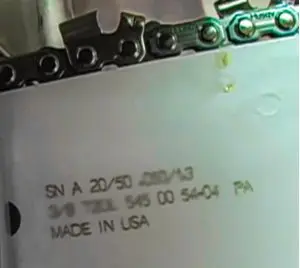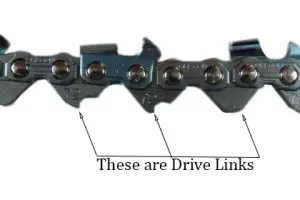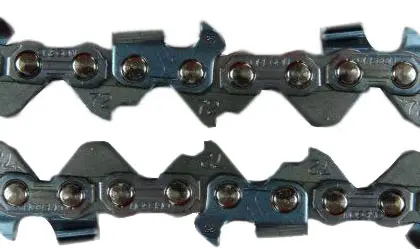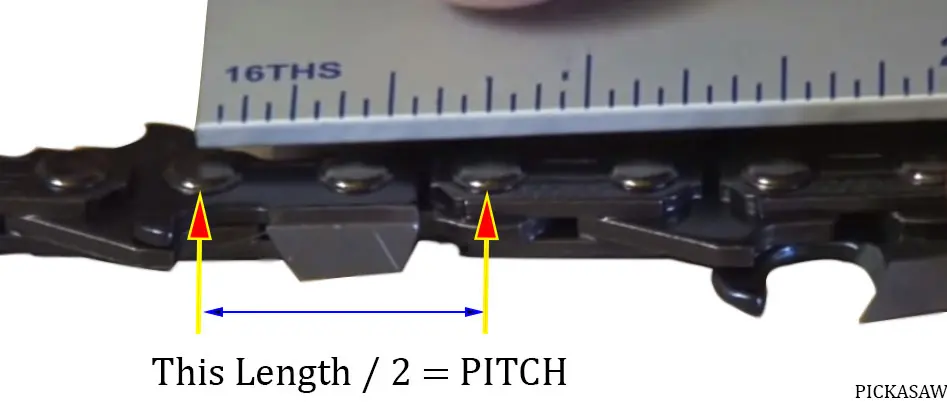There comes a time in every chainsaw owner’s life when they have to change the chain on their chainsaw. When that time comes, you will want to read the information stamped on your chainsaw bar. There are three sets of numbers that you will find stamped on a chainsaw bar.
Unfortunately, after years of use and abuse, these numbers may be hard to read. Also, some bars do not have these numbers stamped on them.
So what do you do when the information you need is no longer available? Well, there is only one thing to do, measure the chainsaw chain length. Obviously, this is easier said than done as there are several factors that determine the length of a chain.

This brings me to the topic of today, how to measure a chainsaw chain. Thus, in this article, we will be discussing how to measure pitch and gauge. Also, I will be discussing how to count the number of drive links.
Determining the correct chain size for your chainsaw is never easy. First, there are three types of measurements that are crucial to the process of finding the correct chain size. Secondly, you have to factor in the size of your chainsaw bar.
That being said, let us look at how to measure chainsaw chain length.
The Number Of Drive Links
Out of the three, the number of links is the easiest to calculate. Also called lugs, links protrude from the underside of the chain and power the chain by grabbing the drive cog. Counting the number of links on a chain is easy and requires no specialized tools.

However, it can be frustrating, especially if you miss even a single link. To easily count these links without missing even a single one, place the chain on a flat surface. Make sure the drive links are facing each other.

Measuring The Pitch
While counting the number of links is easy enough, the same cannot be said about How to find out chainsaw chain pitch and gauge. Measuring a chain’s pitch and gauge requires the use of precision tools such as scale or dial calipers.
Starting with the pitch, this is the distance between links. To get a chain’s pitch distance, measure the distance between any three rivets. Then divide the result by two. Some of the most common pitch measurements include 0.325 inches and 0.404 inches.

The pitch of a chain will be imprinted on the chain. In some instances, it is imprinted on the bar. Manufacturers have different ways of communicating the pitch of their chains. This information can also be found online.
Measuring the gauge
Lastly is the gauge, which refers to the width of the lugs on a chain. To measure this small measurement, you will need a dial caliper.

Some standard gauge measurement includes 0.043, 0.050, 0.058 and 0.063 of an inch.
The size of the bar
The chainsaw bar is the part of a chainsaw that connects to the motor housing. This is the part that the chain wraps around. The size of this bar will greatly impact the size of the chain you should get.
There are two measurements you need to get in regards to the bar. The first is the cutting length. To get this measurement, line up your tape measure with the edge of the bar. Measure from where the bar connects to the chainsaw casing to the furthest tooth of the chainsaw nose.
Ideally, the measurement you get should range between 12 and 20 inches. The other measurement you need is the entire length of the bar. To measure this, remove the chainsaw casing and measure the entire bar.
What do the numbers mean on chainsaw chains?
Chains will have the pitch, gauge, and the number of links stamped on them. These are usually the numbers you find appearing on a chain. Sometimes these numbers will appear jumbled up with other numbers.

All in all, if you are wondering what do the numbers mean on chainsaw chains? They represent the pitch, gauge, and number of driver links.
Why these measurements matter
So what is the best chainsaw chain? To answer this question, you need to consider all the measurements I have outlined above. Generally speaking, the pitch, gauge, and the number of links of a chain will determine what kind of cutting it’s suited for.
In this regard, chains with a pitch of .404 inches are best suited for heavy-duty applications. These are the kind of chainsaws you will find being used by firemen. The greater the distance between the links, the more aggressive the cutting.
On the other hand, chains with a .325 inch pitch are more suited to low profile cutting. These are the chains you will find on chainsaws whose bar length is below 18 inches. These are mostly medium-sized non-professional cheap chainsaws.
The gauge will influence how well the chain grips the bar. The thickness of the drive links that connect the chain to the bar requires a clipper. If you do not have a clipper, the best thing to do is take the chain to a professional.
What length chain should I get?
The length of a chain is determined by the pitch and the number of links on the chain. On new chains, this information will either be imprinted on the chain or in the manual. Once you have gotten the pitch and number of links, the next thing is to find a matching chain.
So what length chain should I get? This all depends on the pitch and number of drive links on your old chain.
Conclusion
Getting a replacement chain that does not match your chainsaw is dangerous. It can lead to the chainsaw being damaged or, worse, an injury. This is why it is important to measure your chainsaw chain before getting a replacement.
If you have trouble getting the essential measurements for any reason, it may be wise to take them to a professional. Overall, these measurements will determine the kind of replacement chain you get for your chainsaw.

3 thoughts on “How To Measure A Chainsaw Chain – 3 Easy Steps!”
Actually, the pitch part I like most. It clears my doubt.
Yeah. Measuring the Pitch is one of the most important and crucial parts in the chainsaw chain.
Can you briefly explain the “Measure the gauge” Part? Actually, I want to know how to measure the chainsaw chain so perfectly. Thank you.